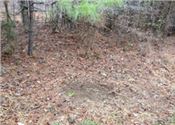|
Deer Communicate With Senses, Scents

Deer create scrapes by pawing away leaf litter under low-hanging branches, leaving their scent
on the ground and on the branches overhead.
Photo by MSU Extension Service/Bronson Strickland
STARKVILLE, MISS.
Deer hunters know all too well the power of a deer’s sense of smell, or more technically speaking, its olfactory system. A change of wind direction can give deer just a whiff of human scent and send them running and send a hunter back to the truck empty handed.
Deer not only use their sense of smell to detect predators, but also to communicate with one another. This deer-to-deer communication relies on a network of locations where deer spread their scent – like on the ground and on trees – and a special group of chemicals called pheromones.
Pheromones are hormones that trigger a social response in animals of the same species. Hormones are chemicals in the body that regulate some function. Deer have a Jacobson’s organ, or more technically, a “vomeronasal organ,” that transports pheromones to the brain for interpretation. Sometimes, a buck will respond by raising its head and curling its top lip. This behavior facilitates the transport of pheromones into the Jacobson’s organ.
Deer use glands to produce pheromones and leave their calling cards throughout their territory. Deer have many different types of glands, with some more obvious than others. The tarsal glands, located on the inside of the back legs of both bucks and does, are very noticeable.
Before and during the breeding season, bucks will urinate on the tarsal glands, and they will become very dark and develop a strong smell. The tarsal gland itself produces a fatty/waxy substance that likely holds important pheromones found in the urine. Researchers have identified chemicals that are present only on doe or buck tarsal glands, as well as different chemicals on older, dominant bucks versus younger, subordinate bucks. This finding suggests deer have pheromonal signals that convey the age class and social status of bucks.
The preorbital and forehead glands also are commonly seen by hunters. The forehead gland is a series of cells that secretes a fatty/waxy substance, much like the tarsal gland, that will coat the hair on the forehead, which is why this part of a buck’s head always appears darker. If you rub the forehead, you will notice the texture of the hair is different and feels oily.
Forehead gland activity increases with the age of the buck, again suggesting the scent chemicals emitted by the forehead gland may signal the social status of the buck. Bucks deposit these chemicals every time they rub their antlers and foreheads on a small tree, leaving an “I was here” mark for others to find.
The preorbital gland, located between the eye and nose, is often seen when a buck is making or visiting a licking branch. Licking branches (branches above scrapes that deer lick and chew on) are usually associated with a scrape – places where deer paw the ground, remove leaf litter and urinate as a way to announce their presence. Bucks also will rub the licking branches with their preorbital gland.
Less is known about the chemicals made in the preorbital gland. Given the frequency that deer use it in scent-marking behavior, the gland is likely very important for communication.
The world of deer-scent communication is much more complicated than many people might assume. Deer don’t need social media to let everyone know where they have been, where they are going or their current relationship status. But, they do have a specialized sensory system that relies on chemical compounds to convey similar information.
Editor’s Note: Extension Outdoors is a column authored by several different experts in the Mississippi State University Extension Service. ∆
|
|